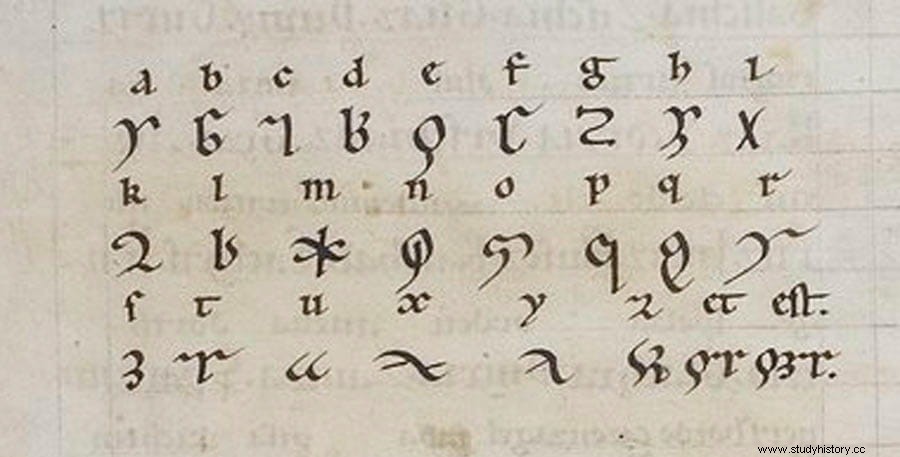The Lingua Ignota is considered the first artificial language in history, created by Hildegard of Bingen in the 12th century, although its purpose is unknown.
Perhaps the most famous artificial languages today are Esperanto and Interlingua, both with considerable numbers of speakers and scholars. It is closely followed by the languages invented by writers such as Tolkien, or those created expressly for television series and movies, the most popular example of which would be Klingon from Star Trek and, more recently, the languages that appear in the Game of Thrones series. /P>
But throughout history there have been attempts to create languages for different reasons, whether aesthetic, artistic, functional or simply for fun. The first artificially constructed language for which documentation is available is the Lingua Ignota (in Latin unknown language ), and was created by Hildegard of Bingen in Germany in the 12th century.

This Hildegard, today a saint of the Catholic Church, was not an ordinary woman. She was a nun and abbess of the Rupertsberg Monastery, where she died in 1179. she Behind her she left a wide musical, scientific and literary work. In the musical aspect, she composed up to 78 works, including a prototype of oratorio , a composition that would not be invented until five centuries later, and an auto sacramental called the Ordo Virtutum , which some consider to be the first opera in history. Since 1979, more than 35 albums with interpretations of her songs have been published, and even in 2001 the movie A Beautiful Mind included one of her songs on its soundtrack.
She wrote works on medicine, politics and theology that are preserved today in numerous codices copied and transmitted by the monks of different monasteries. She in her time was known as the Sibyl of the Rhine and also as the Teutonic prophetess her, she becoming one of the most influential women of the Late Middle Ages in Europe.
Her invention of the Lingua Ignota she earned him to be adopted as patron saint by the Esperantists. This artificial language is collected in her work Ignota Lingua per simplicem hominem Hildegardem prolata , as a list of 1,011 words with their equivalent meaning in German, together with the Litterae ignotae (unknown letters), 23 letters of her creation that make up a new alphabet completely different from those known until then.
It is with this alphabet that Hildegarda wrote her new language, the purpose of which has been the subject of debate over the centuries without reaching clear conclusions. Some think that it had an eminently scientific character, and others that it is primarily related to mysticism.
She formally seems to partially use Latin grammar, substituting some words for newly created ones, as can be deduced from the only preserved text written in Lingua Ignota :
This text is written mixing Latin with five new words, of which only one, loifoi/loifolum (peoples or nations), appears in the list preserved in the codices. This seems to indicate that the vocabulary was actually much broader than those 1,011 words.

From some letters it is also deduced that the existence of the Lingua ignota It was known by relatives and third parties, although it is not known if it was used more than by its creator and, ultimately, it does not seem that anyone cared to speak or study it beyond her death. Some experts believe that its primary use was musical, since some of the words have been traced in the songs that she composed.
Among the words listed in the glossary we find religious terms (Aigonz / God , Diueliz / devil , Zuuenz / saint ), relating to human beings (Inimois / human being , Iur / man , Vanix / woman , Peueriz / father , Corn / mother ), but also scientific and artistic (Pruiuanz / amphora , Dioranz / arc , Lauziminize / Earth , Spartoliz / researcher )
Since the 19th century, numerous editions of the curious language invented by Hildegarda have been published, one of them made by the famous Grimm brothers in 1848. The complete list of words with their meaning in Spanish can be consulted in the PDF edition of the Hildegardiana website .
